A Case in Point.
The As the transient twenty tens whistled by in a whirlwind of technological titillation, political malaise and steadily increasing ADHD, precious few luxuries pertaining to traditional computing were poised more precariously on the precipice of extinction than the monolithic metal receptacle positioned in close proximity to the rectangular oracle which showcased its arcane abilities. In layman’s language, this troubled author is lamenting his generation’s progressive disinterest in a product that any prudent PC enthusiast would find tougher trade-up than their speakers, swivel chair, or mother’s antique lampshade collection.
Throughout my ceaseless crusade to master the cryptic science of cable management and provide hoards of battery farmed components with lavish and convenient accommodation I have acquired, furnished and auctioned more ATX cases than a bogus lawyer has filed phony copyright claims.
As these words drift across your corneas, no less than a quarter of a century has elapsed since my laborious search commenced and not a single second extra was required to conclude that paradise in the realm of PCB hospitality is as likely as lottery jackpot on Friday the 13th. If the dimensions were ideal, the décor was dreary. If form and elegance and were beyond reproach, the interior was poorly conceived and ran too hot. When all practical needs were satisfied, the design was inevitably vulgar, as if its originators had assumed that the average custom builder would also covet six packs, tattoos, cultivated beards and visit the gym five times a day parking their souped-up motor cycle on the pavement outside the entrance because they were too lazy to cross the road.
On just two momentous occasions did I approach what could be deemed the zenith of finely fabricated silicon sanctuary. The first was in early 2004, when Baron von Intel’s supremacy in the murderous microprocessor war was briefly nullified by his arch nemesis, the abominable AMD, in an age when the latter’s pictorial prowess existed as separate entity. At the time, the market for fashionable cases was both nascent and decidedly niche. The prevailing proportion of towers and desktops occupying laminated Beachwood real estate invariably comprised of beige plastic fascias, unpainted steel frames, and enough sharp edges to shave a heard of genetically augmented sheep.
Approximately a decade earlier, Taiwanese based company Cooler Master had emerged as a competent manufacturer of high quality heat sinks and quickly established a firm foothold in the OEM sector. At the turn of the millennium, its historic ATC-100 rolled off a production line somewhere in China.
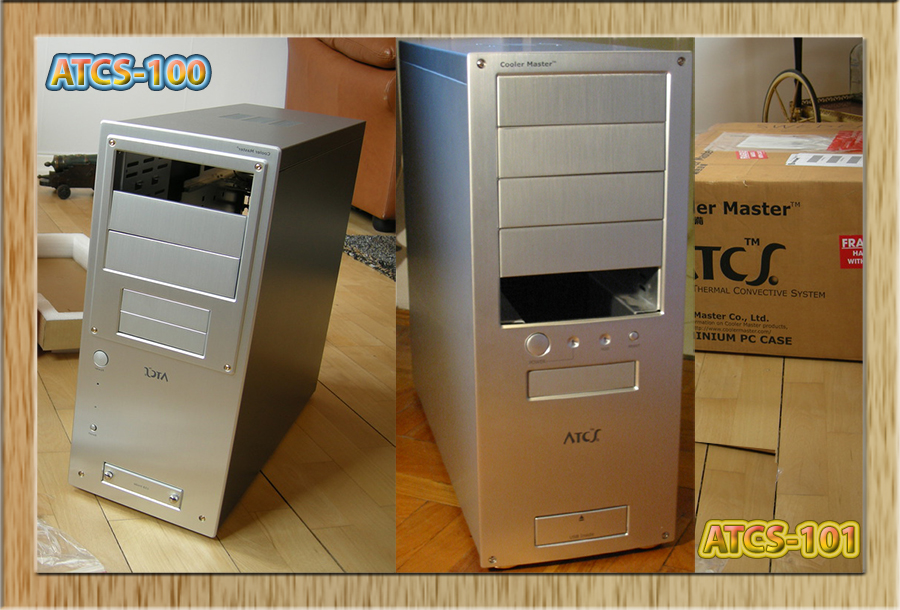
An enchanting mid tower chassis forged fully from premium brushed aluminium, the soft sheen of its silky side panels shimmering under sterile factory fluorescence.
To PC sages starved of aesthetics to silence their Apple crazed rivals, it was a gift from hardware heaven and arguably the pioneering realisation of a top tier tailored system assembled entirely by the customer. The case was swift to spawn a succession of thoroughbred siblings until the “ATCS” moniker had blossomed into a revered brand, with each resulting product as desirable as a Rembrandt original. Amongst those most sought after were:
The ATC-200
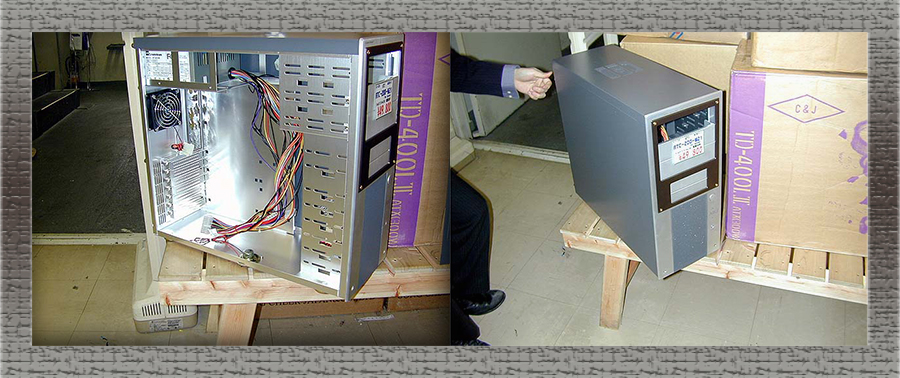
Proportionally identical to the 100 but with a shiny black bezel surrounding the drive bays, a fine mesh grill replacing the front mounted USB ports and a pair of 80mm intake fans positioned directly behind it to optimise airflow over the hard drives and improve overall ventilation by working alongside identical exhaust fans on the top and rear.
The ATC-101 – Pictured above beside the 100 and best defined as it’s bigger brother with a revised button/LED layout and two additional 5.25 inch drive bays at the expense of one 3.5.
The ATC-201b-btx
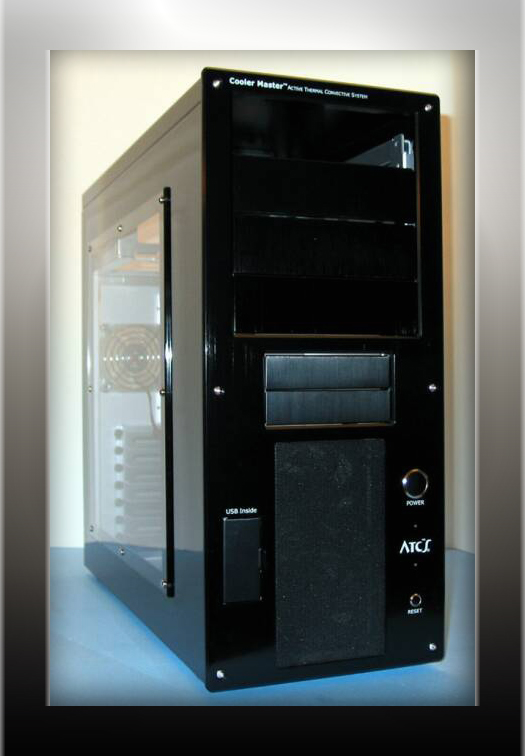
Also christened the “Black Widow”. One of several”201″ branded brothers and considered definitive by many, this particular revision boasted an aluring coat of glossy black paint along with a turquoise acrylic observation window on the left side panel. One of its more common silver counterparts formed the basis of my debut attempt at bespoke perfection.
However, none these ravishing relics ignited my desires to the same degree as their flagship descendant. Beyond doubt one of the most sought after cases of its era. A flawless masterpiece that compelled me to consult search engines as frantically as a hypochondriac who’d swallowed a scotch bonnet. A semi-precious alloy sculpture so appealing to my intoxicated senses that I purchased two with a plan to flog the second for a massive profit, before eventually selling it at a third less despite a fawning 500 word review to complement the listing.
I am of course referring to the, historic, the iconic the legendary ATCS-110
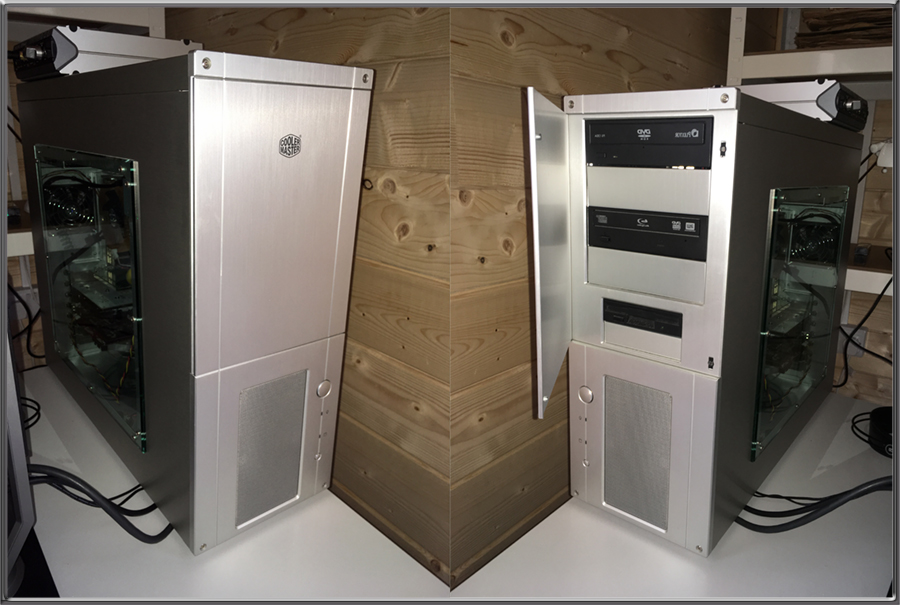
And there it is. My very own. In faithful service to this day, or at least when I typed what you presently peruse, which could well be long after my soul has succumbed to toilsome technological transience. One thing is certain, this delectable enclosure for post millennial micro technology is destined to survive its master. Like an ageless antique timepiece it shall become a cherished heirloom, passed down through generations of tinkering techies endowed with an eye for retrospective elan. There are periods during a company’s existence when its investors, management team and workforce are are all singing from the same spreadsheet. Such elusive corporate synchronicity leads to a significant boost in logic, assiduous and efficient manufacturing and conspicuous designs untarnished by cumbersome gimmicks or profit-seeking reductions in standard.
Coolermaster’s ATCs Annals were a spectacular showcase of how not to fix what hasn’t failed. A phenomenon as rare in the computer industry as a riveting three hour lecture on the subject of commercial scalability accompanied by more slides than selfies on a narcissist’s mobile and perhaps fittingly, such purple patches are all too fleeting. In 2003, when a sizeable chunk of Coolermaster’s artisans splintered to setup their own rival company Silverstone, any semblance of classical charm departed with them. Moreover, when these same talented engineers attempted to re-render former glories, the resulting charlatans/pretenders though convincing to some, were devoid of the magical lustre and refined craftsmanship so lovingly embodied in their elders.
There was the Nimitz Tjo3, hailed boldly as the 110’s “spiritual successor”and readily adopted as its direct substitute by the distinguished OEM builder “Falcon Northwest”
It looked the part in photos and was probably the closest that any case has come to tastefully replicating the fabled 110. However, where new and practical features might have promoted efficiency, they were instead marred by counter productive cosmetics. The single 120mm front intake fan would have been a constructive substitute for the twin 80mm units offered by the 110 were it not for the addition of lower door which greatly impeded the airflow when closed. To compound this sloppy oversight, the case was markedly longer, meaning that what little cool air was able enter it had heated up before reaching areas most prone to high temperatures.
The Tj10, released three years later, did much to address this shortfall by introducing dedicated ventilation positioned between an isolated hard drive chamber and the system’s critical components. Fresh air was drawn through a central duct by the case’s single 120mm intake fan where it could supply the motherboard, CPU and video cards with immediate and effective cooling.
So, what was not to like? How to express this discreetly. It’s no good. Frankly, I must be frank. Imagine an ATC-110 on a rigorous body building regime and a cocktail of anabolic steroids. Got it? Thought so. Big can indeed be beautiful but not when one has to walk like they’ve had a trouser accident in order to preserve their ability to procreate.
To be specific, the aluminium was coarser, cruder, rough under the fingertips and exhibited no subtle, soft sheen when subjected to glowing/cosy bedroom lamplight. It was also less resistant to the fingerprints and far harder to relieve of dust, grime and those unsightly smears from when you simply had to install that gleaming new graphics card before washing buttery toast crumbs from your eager paws. Water, baby oil and other popular cleaning materials merely burrowed down into the grain resulting in an abstract landscape of stains, blobs and streaks.
It would be erroneous to imply that such meticulous criticisms were echoed by the majority of Silverstone’s earliest adopters, indeed, the company would go on to garner abundant respect from a wealth of aesthetically conscious Do-IT-Yourselfers, especially those who’d never glimpsed an atcs case in the metal. However, there was yet a third manufacturer that had been enticing the same demographic for longer than either of those aforementioned. Before names such as Fractel Design, Corsair, Phanteks and Thermaltake were self-conscious squiggles on their founder’s whiteboards. If fact, this company was born during decade when terms such as puff ball, yuppie, power ballad, Sir Clive Sinclair and the tedious request, please rewind before returning , resided at contemporary culture’s cutting edge. Though Little is known about Lian Li’s initial activities, by the late 90s, they commanded the same reverence as Coolermaster through a lineage of similar designs produced with equal craftsmanship and were vastly more prolific.
I came into contact with a crop of their early incarnations and although none evoked my unconditional acclaim, they performed honourably as the basis for opulent backup rigs.
There was the Pc-60, the firm’s debut case, available in the same year as Coolermaster’s and bearing a passing resemblance to its rival in terms of size, structure and functional characteristics.
Its design served as the template for more derivatives than there are plot-holes in a popular sci-fi drama. Perhaps the most divisive remix was this captivating cadenza of copper, whose resplendent golden brown livery inspired this very website’s controversial colour scheme .
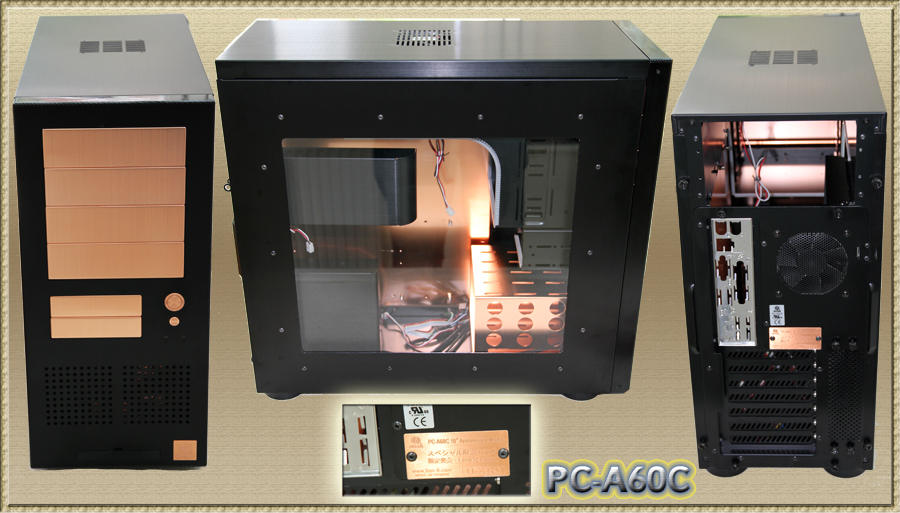
Released to celebrate Lian Li’s 10th anniversary. worldwide distribution was strictly limited, with each unit exhibiting an engraved plaque denoting its rarity and serial number. Of course I had to have and, as of this moment, it remains in my possession, having been sanitised, boxed, un-boxed and reinstated on the five occasions that a potential purchaser failed to meet by modest sale price.
The PC-A60C wasn’t the only eccentric novelty that incited controversy. Indeed, extravagant exclusivity would become one of Lian Li’s more dubious stocks in trade, with many condemning the results as acts of pretentious commercialism. If any excuse arose to engineer something commemorative, avant guard and prohibitively expensive, the Taiwanese manufacturer seemed more eager to impress than a surrealist architect artist with a Royal commission.
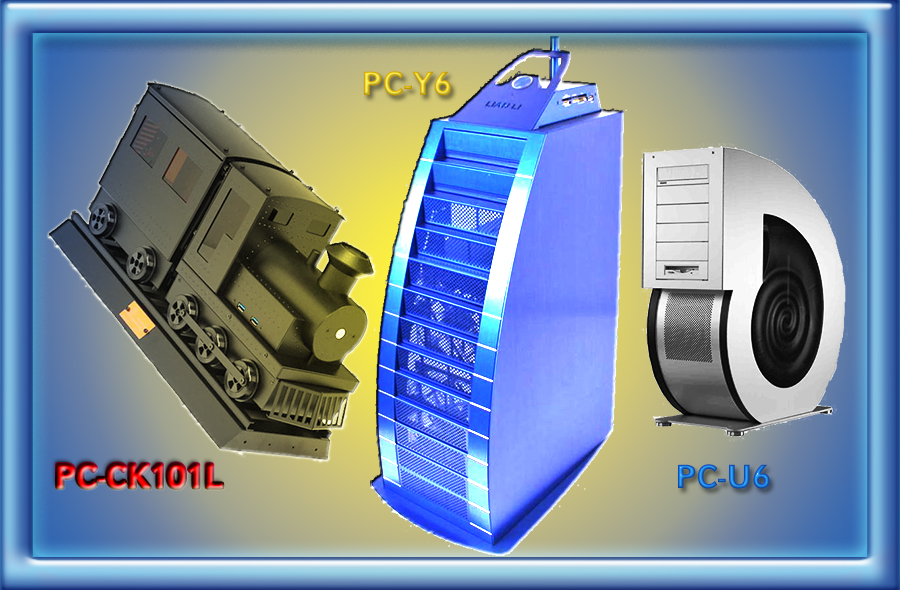
Sails, Sea Shells and Steam Trains were just three of the themes behind a bizarre array of concept cases.
However, It wasn’t until Winter 2013 that I formed an infallible bond with one of Lian Li’s radical innovations and ironically, this particular creation was the stylistic antithesis of Coolermaster’s finest. If the ATC-110 had been an amalgam of spellbinding minimalism the PC-P80N was a tribute to cosmetic brutality.
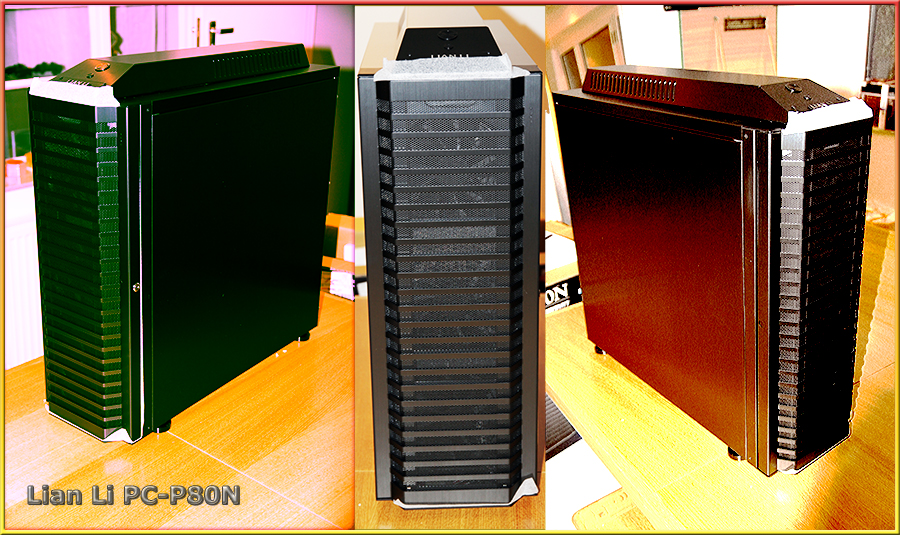
A dreadnought? A fortress? A cyborg Bunnie’s hutch or Darth Vader’s medicine cabinet? It mattered not. For my priorities now extended beyond the skin deep. Hardware had evolved dramatically from the days when I would struggle to smoke out a heat-sink capable of keeping a power guzzling processor from blowing its core, or concern myself over the welfare of an infernal GPU that would emit enough heat to to fry a hedgehog’s breakfast and keep the coffee warm in case Alfie the vole stopped by for a late morning natter.
With the development of climate change in affluent harmony with prestigious accolades for any technological embodiment of conservation, one might have assumed that less, smaller and cooler were welcome certainties. Regrettably, the term welcome would have only applied if the actual number of key components had not increased, but they did. By precisely one hundred percent.
Where previously a single graphics card and processor had each laboured in noble solitude, they could now conquer life’s binary hardships with an identical soulmate. A classic demonstration of one step forward, two steps back. Fret not, I’m aware of the knock-down argument. Nobody was forcing me to pull out all the stops, to maximise my rig’s potential, to stuff it so full of peripherals that it needed an enclosure large enough to let to a spoilt single mother. Capitulating to the decadence that I denounce makes me a hypocrite. One of everything would have been plenty. What obsessive, insecure hoarder can only rest easy in the knowledge of having gained ten superfluous frames per second?
No, I still refuse to be numbered amongst such fickle fanatics. Every tortured techno-file can be defined by one of four descriptors in accordance with their taste and temperament. These are as follows; The stubborn, The shrewd, The stylish and the The Spoilt. Here is a brief analysis of each.
The Stubborn. These are staunch individualists who will instinctively and vociferously resist change. Having invested in a system that met their demands say, five Christmases earlier, they will now row savagely against the currents/tide of contemporary consumerism, doggedly asserting that “new and improved” could not possibly reward them with anything of interest or merit beyond what they already possessed and worked perfectly. Authors, retired programmers and organisers of bake sales in close knit rural communities with populations of less than 600, might be typical examples of a stubbornist
The Shrewd. Shrewdists by contrast are reflective and stoical, resigned to paradigm shifts in the digital landscape and the painful transactions they necessitate, though not in the short term. If an upgrade is unavoidable, it must be one that will survive the next bi-annual refresh and at minimum, the one after that. Additionally, the choice of components is crucial.
They must be scarce, unorthodox and in a class above the conventional top tier so as to form an impregnable bond with the builder and thus assuage any temptation to elope with something more common, even though it might be faster. The Shrewdist’s concoction is also predicated on longevity and must therefor harbour industrial grade solutions for mission critical applications…excluding the odd spot of gaming. The logic being that if something is targeted at monstrous money munching corporations, it is less likely to exhibit the flaws engineered by monstrous money munching corporations.
Anything aggressively advertised or easily sourced is a virtual guarantee of the insidious obsolescence so frequently endured by the humble consumer and which ultimately, is far more damaging to student loans, planned holidays, happy marriages and general sanity. For anybody who hasn’t noticed, this philosophy just happens to coincide with my own and I hasten to add, provides a roundly plausible explanation for periodic profligacy should anybody dare to suggest there is the slightest similarity between the shrewd and the spoilt.
The Stylish. Were I to follow my mother’s advice, this category would account for myself. It consists of proactive optimists with an irrepressible instinct to procure premium performance for the price and specifically, by employing techniques that circumvent pre-existing parameters. The stylish take no greater pleasure than in preaching, primarily to the shrewd, about how a cunning combination of prudent purchases and skilled tweaking has yielded a system that punches a sizeable percentage of frequencies and frame rates above its stock specifications and moreover, for well below half the cash. Their curious nature and relentless urge to publicly breach official guidelines is as much of a curse as a blessing, commonly coaxing them to embark upon a cumbersome quest for the minuscule speed bonus necessary to humble a forum full of self-centred spendthrifts.
Ironically, the desperate measures they resort to will often generate instabilities that end up devouring far more resources than if they had simply subdued their irrational pride and acquired a faster CPU to begin with,. but that would be cheating. If a thirty second viral video a can demonstrate that a three hundred dollar mainstream processor can best a multi-core monster costing five times as provided its run under a heavily customised nickle plated copper water block on a dedicated loop connected to a class leading pump, reservoir and radiator filled with the contents of an ice queen’s tears filter jug and cooled by a pair of industrial grade ceiling fans ceiling fans, then the glory wholly justifies the graft.
The Spoilt. Little explanation is needed. These are self-serving cyber junkies bestowed with scarce knowledge, scant attention spans and more money than common courtesy, let alone sense. Their flamboyant disposition on social media serves merely as catalyst for narcissism and titillation for hordes of enraptured disciples rather than any useful or informative endorsement of whatever they appear to be “reviewing”. They can never be interested in a gadget for longer than it takes to film themselves taking it out of a box, removing several sheets of cellophane, stroking it, sniffing it, placing it alongside last month’s model, pointing out that its bigger….or smaller, showing their viewers an on button, pressing it, claiming ecstatically that the welcome screen might just be the greatest welcome screen in the history of welcome screens and using the word AWESOME two hundred and thirty seven times.
Hold on a moment, mutters the reader’s critical conscience. I can’t abide by such brazen pontificating. Having wandered wilfully from this article’s principal subject, we now appear to be confusing the self-sufficient hobbyist with an insatiable adopter of ready-made gimmicks, since when did video cards, motherboards or processors feature their own welcome screens?! An astute observation with a cogent defence. The point being that if any extrovert e-tail addict had once mustered the motivation to devise and construct a dream PC, their capricious character and lack of patience would have caused them rapidly to abandon home-brew artistry. They do not possess the concentration or resolve necessary to utilise even half of their creation’s functionality. To immerse themselves in an RPG as one might digest an engaging novel, to produce content containing something other than their own rudimentary opinions about the equipment they have just produced it on.
They seem decidedly more stimulated by repeatedly running cosmic definition benchmarks depicting slowly collapsing Aztec architecture, camp soldiers in skintight uniforms or leviathans leaping over jet propelled galleons before fawning over some tawdry Hall of Fame with their childish avatar In pole position. Predictably, the satisfaction garnered from such arrogant self-indulgence wears off faster than a Buddhist Monk’s hangover, Great White Shark’s indigestion, leaving them only one way to realise their ultimate goal of instant and recurring gratification without the hassle of screws, cables, pointy corners, thermal grease and more than five minutes of their fathomless free time. This sole solution? Go Apple!
Now, perhaps you can comprehend the entirely rational motif behind such an epic deviation. It was a means of expressing the author’s unmitigated animosity towards an omnipresent autocratic monstrosity hell bent on robbing proud heretics of their rights to individualism, not least that which permits one to appoint their own housing. Yet, as we return with weary eyes and to something resembling the topic in hand, it was I who was about to concede this very privilege, though not I emphasise in humiliating and unequivocal surrender to the New World Orchard. On the contrary. Specifying a case is only one part of a custom build, vital to be sure, but far from obligatory. Swapping graphics cards during a bench test or unknotting cobwebs of cables when retiring an elderly power supply were two scenarios where the practice of “enclosed computing” would more likely impede than assist. Furthermore, my war with environmental hindrances was proving fruitless. Degrees continued to escalate in perfect correlation with stress, eventually leading to unbearable night terrors of defenceless transistors perishing amidst an inferno precipitated by their negligent master, who was promptly tried for involuntary machine slaughter and condemned to an eternity of servicing Lucifer’s hyper eco-conscious air conditioning system. My profound hope was to dispel such horrific manifestations whilst simultaneously shunning any hint of the draconian convention so readily embraced by enraptured Apployltes, and one bold decision was all I would require to fulfil it.
In the past, when digesting reviews for the latest hardware or conversing with a legion of customer service reps, usually mere moments before receiving an RMA number, I’d become aware for the phrase “open bench”. The term refers to a condition under which certain components are tested, either for the purpose of extracting additional performance or to replicate and diagnose defects. The procedure always incurred my displeasure, for whenever I returned a faulty product, its operational shortfalls were invariably symptomatic of excessive heat, an ailment greatly alleviated by excluding what I considered an essential ingredient for a functional and practical system.
Of course you can overclock it to the stratosphere. No doubt you can’t observe the intrusive artefacts and errant distortions I complain of, Yes, I’m sure you left it running for 12 hours without a single lock-up. Perhaps that’s because you’ve installed it on a table next to an open window and an exceptionally powerful north wind, who in the name of sanity would make a routine out of that?! Somebody who enjoys losing their credit card in a mountain of exposed circuitry, those who take pride in an office that looks like robot squatter’s hovel, a twisted masochist who garners pleasure by repeatedly snagging their limbs on swaths of razor sharp solder joints?
Who would have guessed that a life-changing compromise would evolve from such rhetorical bitterness, until a casual spate of armchair window shopping lead me to this… sub-section entitled “test chassis” on the website of a reputable e-tailer from which I’d ordered several times in years gone by.
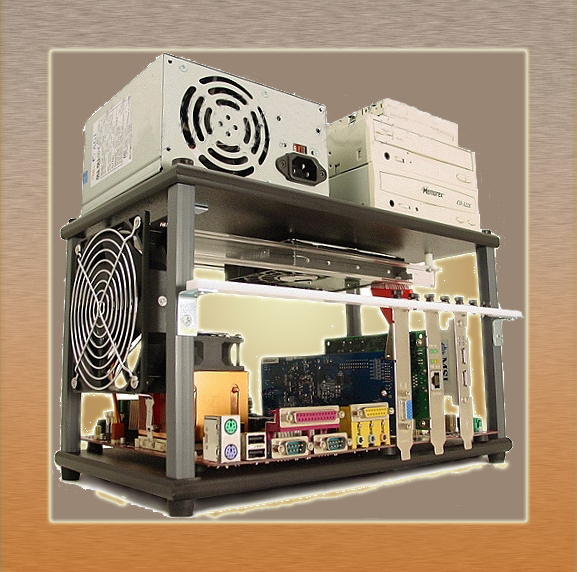
This was the sole item listed, but it was perfect. With it I’d be absolved of all my heat crimes. I could become a leading activist for the welfare of hot-housed micro-chips and preserve the precious time I’d hitherto squandered whist squinting for lost screws, routing connectors through ill-appointed holes lined with flimsy rubber grommets intended to shield wires and fingers from sharp edges which popped our every time you dared touch them with a wire of finger, wrestling with yet another “patented” mounting mechanism that was about as intuitive as a flat pack nuclear reactor.
Scrabbling frantically for my flexible monitory go-between, whose surface bore a tangle of scars inflicted by pennies, pounds and pen knives and had somehow survived half a dozen rinse and spins, I hastily shuttled my cursor over to where an”add to basket” applet should have nestled, only to discover a small and symbolic red square adjacent to the familiar and intolerably tiresome phrase out of stock” discontinued”. No matter, to a fastidious tinkerer, the prospect of uninhibited accessibility at almost no cost to structural procession was worth a voyage across the seven seas, never mind seven minutes of diligent Googling.
With my hobbyist’s antennae bristling in anticipation, I was soon frequenting the manufacturer’s website, whose homepage proudly advertised several notably enhanced reworks of the product that had arrested my attention including, to my enraptured delight, an HTPX variant for my beloved EVGA SR-X. The Top Deck Tech Station, I mused shortly after a chorus of financially binding clicks, would be my passport to open plan paradise.
One week and a sizeable wack of import duty later, I had taken tentative delivery of the. Tentative because to lessen the risk of shipping induced scars and avoid yet further expenditure, I had purchased the kit in its disassembled state and thus, might well be obliged to assimilate instructions translated by a potted language student referencing a multitude of screws, bolts and pegs, all of which looked identical and worse still, decipher diagrams more dense and complex than the blueprint for a portable bio research facility. I need not have fretted.
The instructions were flawlessly conveyed, featured photographs to illustrate each stage of the construction process and even included a friendly preface informing the user of how orientation references should be interpreted in as well as the tools required and approximate assembly time. In hindsight, the latter was the only advice with which I’d quibble, since it did not account for a builder who had, fortuitously, elected to take over one hundred and twenty photographs chronicling his chronic clumsiness and whose sense of direction rivalled that of a whirling dervish on a merry go round.
The aforementioned fact also explains why, when browsing this gargantuan gallery, an observant reader will note that a few cursory shots before its conclusion, the PCI card brace magically changes positions, initially having been installed on the wrong side of the connected vertical supports and therefor, misaligned with the motherboard’s expansion slots!
To compound my incompetence I had secured the motherboard to the upper deck and was attempting furiously to fit a pair of Nvidia’s flagship “polygonists” before noticing this pathetic mistake.




